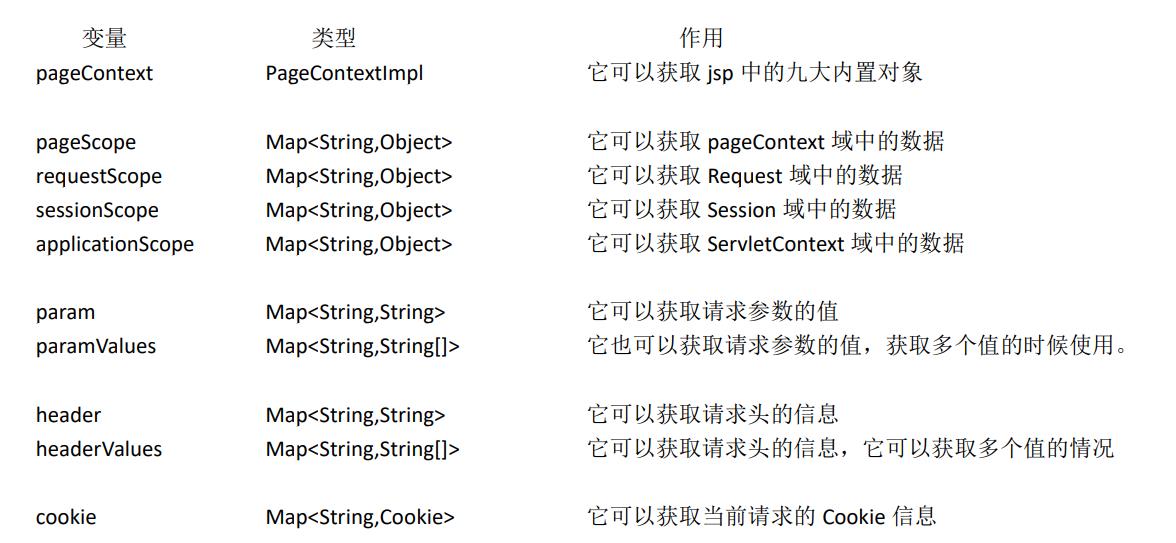EL 表达式 & JSTL 标签
Posted 陕西五花肉
tags:
篇首语:本文由小常识网(cha138.com)小编为大家整理,主要介绍了EL 表达式 & JSTL 标签相关的知识,希望对你有一定的参考价值。
1.EL 表达式
a)什么是 EL 表达式,EL 表达式的作用?
EL 表达式的全称是:Expression Language。是表达式语言。
EL 表达式的什么作用:EL 表达式主要是代替 jsp 页面中的表达式脚本在 jsp 页面中进行数据的输出。
因为 EL 表达式在输出数据的时候,要比jsp 的表达式脚本要简洁很多
<body>
<%
request.setAttribute("key","值");
%>
表达式脚本输出 key 的值是:
<%=request.getAttribute("key1")==null?"":request.getAttribute("key1")%><br/>
EL 表达式输出 key 的值是:${key1}
</body
b)EL 表达式搜索域数据的顺序
EL 表达式主要是在 jsp 页面中输出数据。
主要是输出域对象中的数据。
当四个域中都有相同的 key 的数据的时候,EL 表达式会按照四个域的从小到大的顺序去进行搜索,找到就输出。
<body>
<%
//往四个域中都保存了相同的 key 的数据。
request.setAttribute("key", "request");
session.setAttribute("key", "session");
application.setAttribute("key", "application");
pageContext.setAttribute("key", "pageContext");
%>
${ key }
</body
c)EL 表达式的 11 个隐含对象


EL 获取四个特定域中的属性
pageScope ====== pageContext 域
requestScope ====== Request 域
sessionScope ====== Session 域
applicationScope ====== ServletContext
<body>
<%
pageContext.setAttribute("key1", "pageContext1");
pageContext.setAttribute("key2", "pageContext2");
request.setAttribute("key2", "request");
session.setAttribute("key2", "session");
application.setAttribute("key2", "application");
%>
${ applicationScope.key2 }
</body>
.
pageContext 对象的使用
<%
pageContext.setAttribute("req", request);
%>
<%=request.getScheme() %> <br>
1.协议: ${ req.scheme }<br>
2.服务器 ip:${ pageContext.request.serverName }<br>
3.服务器端口:${ pageContext.request.serverPort }<br>
4.获取工程路径:${ pageContext.request.contextPath }<br>
5.获取请求方法:${ pageContext.request.method }<br>
6.获取客户端 ip 地址:${ pageContext.request.remoteHost }<br>
7.获取会话的 id 编号:${ pageContext.session.id }<br
JSTL 标签库(次重点****)
JSTL 标签库 全称是指 JSP Standard Tag Library JSP 标准标签库。是一个不断完善的开放源代码的 JSP 标
签库。
EL 表达式主要是为了替换 jsp 中的表达式脚本,而标签库则是为了替换代码脚本。这样使得整个 jsp 页面
变得更佳简洁
f) JSTL 标签库的使用步骤
1、先导入 jstl 标签库的 jar 包。
taglibs-standard-impl-1.2.1.jar
taglibs-standard-spec-1.2.1.jar
2、第二步,使用 taglib 指令引入标签库。
<%@ taglib prefix=“c” uri=“http://java.sun.com/jsp/jstl/core” %>
g)core 核心库使用
i. <c:set />(使用很少)
作用:set 标签可以往域中保存数据
<%--
i.<c:set />
作用:set 标签可以往域中保存数据
域对象.setAttribute(key,value);
scope 属性设置保存到哪个域
page 表示 PageContext 域(默认值)
request 表示 Request 域
session 表示 Session 域
application 表示 ServletContext 域
var 属性设置 key 是多少
value 属性设置值
--%>
保存之前:${ sessionScope.abc } <br>
<c:set scope="session" var="abc" value="abcValue"/>
保存之后:${ sessionScope.abc } <br>
ii. <c:if />
if 标签用来做 if 判断。
<%--
ii.<c:if />
if 标签用来做 if 判断。
test 属性表示判断的条件(使用 EL 表达式输出)
--%>
<c:if test="${ 12 == 12 }">
<h1>12 等于 12</h1>
</c:if>
<c:if test="${ 12 != 12 }">
<h1>12 不等于 12</h1>
</c:if>
iii. <c:choose> <c:when> <c:otherwise>标签
作用:多路判断。跟 switch … case … default 非常接近
<%--
iii.<c:choose> <c:when> <c:otherwise>标签
作用:多路判断。跟 switch ... case .... default 非常接近
choose 标签开始选择判断
when 标签表示每一种判断情况
test 属性表示当前这种判断情况的值
otherwise 标签表示剩下的情况
<c:choose> <c:when> <c:otherwise>标签使用时需要注意的点:
1、标签里不能使用 html 注释,要使用 jsp 注释
2、when 标签的父标签一定要是 choose 标签
--%>
<%
request.setAttribute("height", 180);
%>
<c:choose>
<%-- 这是 html 注释 --%>
<c:when test="${ requestScope.height > 190 }">
<h2>小巨人</h2>
</c:when>
<c:when test="${ requestScope.height > 180 }">
<h2>很高</h2>
</c:when>
<c:when test="${ requestScope.height > 170 }">
<h2>还可以</h2>
</c:when>
<c:otherwise>
<c:choose>
<c:when test="${requestScope.height > 160}">
<h3>大于 160</h3>
</c:when>
<c:when test="${requestScope.height > 150}">
<h3>大于 150</h3>
</c:when>
<c:when test="${requestScope.height > 140}">
<h3>大于 140</h3>
</c:when>
<c:otherwise>
其他小于 140
</c:otherwise>
</c:choose>
</c:otherwise>
</c:choose>
iv. <c:forEach />
作用:遍历输出使用。
- 遍历 1 到 10,输出
示例代码:
<%--1.遍历 1 到 10,输出
begin 属性设置开始的索引
end 属性设置结束的索引
var 属性表示循环的变量(也是当前正在遍历到的数据)
for (int i = 1; i < 10; i++)
--%>
<table border="1">
<c:forEach begin="1" end="10" var="i">
<tr>
<td>第${i}行</td>
</tr>
</c:forEach>
</table>
2. 遍历 Object 数组
示例代码:
<%-- 2.遍历 Object 数组
for (Object item: arr)
items 表示遍历的数据源(遍历的集合)
var 表示当前遍历到的数据
--%>
<%
request.setAttribute("arr", new String[]{"18610541354","18688886666","18699998888"});
%>
<c:forEach items="${ requestScope.arr }" var="item">
${ item } <br>
</c:forEach>
3. 遍历 Map 集合
示例代码:
<%
Map<String,Object> map = new HashMap<String, Object>();
map.put("key1", "value1");
map.put("key2", "value2");
map.put("key3", "value3");
// for ( Map.Entry<String,Object> entry : map.entrySet()) {
// }
request.setAttribute("map", map);
%>
<c:forEach items="${ requestScope.map }" var="entry">
<h1>${entry.key} = ${entry.value}</h1>
</c:forEach>
4. 遍历 List 集合—list 中存放 Student 类,有属性:编号,用户名,密码,年龄,
电话信息
Student 类:
public class Student {
//4.编号,用户名,密码,年龄,电话信息
private Integer id;
private String username;
private String password;
private Integer age;
private String phone;
示例代码:
<%--4.遍历 List 集合---list 中存放 Student 类,有属性:编号,用户名,密码,年龄,电话信息--%>
<%
List<Student> studentList = new ArrayList<Student>();
for (int i = 1; i <= 10; i++) {
studentList.add(new Student(i,"username"+i ,"pass"+i,18+i,"phone"+i));
}
request.setAttribute("stus", studentList);
%>
<table>
<tr>
<th>编号</th>
<th>用户名</th>
<th>密码</th>
<th>年龄</th>
<th>电话</th>
<th>操作</th>
</tr>
<%--
items 表示遍历的集合
var 表示遍历到的数据
begin 表示遍历的开始索引值
end 表示结束的索引值
step 属性表示遍历的步长值
varStatus 属性表示当前遍历到的数据的状态
for(int i = 1; i < 10; i+=2)
--%>
<c:forEach begin="2" end="7" step="2" varStatus="status" items="${requestScope.stus}" var="stu">
<tr>
<td>${stu.id}</td>
<td>${stu.username}</td>
<td>${stu.password}</td>
<td>${stu.age}</td>
<td>${stu.phone}</td>
<td>${status.step}</td>
</tr>
</c:forEach>
</table>
以上是关于EL 表达式 & JSTL 标签的主要内容,如果未能解决你的问题,请参考以下文章